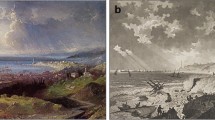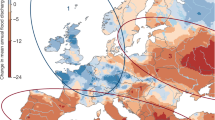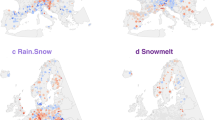Abstract
There are concerns that recent climate change is altering the frequency and magnitude of river floods in an unprecedented way1. Historical studies have identified flood-rich periods in the past half millennium in various regions of Europe2. However, because of the low temporal resolution of existing datasets and the relatively low number of series, it has remained unclear whether Europe is currently in a flood-rich period from a long-term perspective. Here we analyse how recent decades compare with the flood history of Europe, using a new database composed of more than 100 high-resolution (sub-annual) historical flood series based on documentary evidence covering all major regions of Europe. We show that the past three decades were among the most flood-rich periods in Europe in the past 500 years, and that this period differs from other flood-rich periods in terms of its extent, air temperatures and flood seasonality. We identified nine flood-rich periods and associated regions. Among the periods richest in floods are 1560–1580 (western and central Europe), 1760–1800 (most of Europe), 1840–1870 (western and southern Europe) and 1990–2016 (western and central Europe). In most parts of Europe, previous flood-rich periods occurred during cooler-than-usual phases, but the current flood-rich period has been much warmer. Flood seasonality is also more pronounced in the recent period. For example, during previous flood and interflood periods, 41 per cent and 42 per cent of central European floods occurred in summer, respectively, compared with 55 per cent of floods in the recent period. The exceptional nature of the present-day flood-rich period calls for process-based tools for flood-risk assessment that capture the physical mechanisms involved, and management strategies that can incorporate the recent changes in risk.
This is a preview of subscription content, access via your institution
Access options
Access Nature and 54 other Nature Portfolio journals
Get Nature+, our best-value online-access subscription
$29.99 / 30 days
cancel any time
Subscribe to this journal
Receive 51 print issues and online access
$199.00 per year
only $3.90 per issue
Buy this article
- Purchase on Springer Link
- Instant access to full article PDF
Prices may be subject to local taxes which are calculated during checkout





Similar content being viewed by others
Data availability
The flood index data that were used in this paper and an extended list of references are available at https://github.com/tuwhydro/500yrfloods. The air temperature data are available at https://www.ncdc.noaa.gov/paleo-search/study/9970
Code availability
The data analysis was performed in R using the supporting package fields for the thin plate spline interpolation (function fastTps). The code used can be downloaded from https://github.com/tuwhydro/500yrfloods.
References
IPCC. Special Report on Managing the Risks of Extreme Events and Disasters to Advance Climate Change Adaptation (eds Field, C. B. et al.) (Cambridge Univ. Press, 2012).
Glaser, R. et al. The variability of European floods since ad 1500. Clim. Change 101, 235–256 (2010).
UNDRR. Global Assessment Report on Disaster Risk Reduction (Geneva, 2019).
Blöschl, G. et al. Changing climate both increases and decreases European river floods. Nature 573, 108–111 (2019).
Camuffo, D. & Enzi, S. in Climatic Variations and Forcing Mechanisms of the Last 2000 Years (eds Jones, P. et al.) 433–450 (Springer, 1996).
Brázdil, R. et al. Fluctuations of floods of the River Morava (Czech Republic) in the 1691–2009 period: interactions of natural and anthropogenic factors. Hydrol. Sci. J. 56, 468–485 (2011).
Schmocker-Fackel, P. & Naef, F. Changes in flood frequencies in Switzerland since 1500. Hydrol. Earth Syst. Sci. 14, 1581–1594 (2010).
Pichard, G., Arnaud-Fassetta, G., Moron, V. & Roucaute, E. Hydro-climatology of the Lower Rhône Valley: historical flood reconstruction (ad 1300–2000) based on documentary and instrumental sources. Hydrol. Sci. J. 62, 1772–1795 (2017).
Wilhelm, B., Vogel, H., Crouzet, C., Etienne, D. & Anselmetti, F. S. Frequency and intensity of palaeofloods at the interface of Atlantic and Mediterranean climate domains. Clim. Past 12, 299–316 (2016).
Wirth, S. B., Glur, L., Gilli, A. & Anselmetti, F. S. Holocene flood frequency across the Central Alps—solar forcing and evidence for variations in North Atlantic atmospheric circulation. Quat. Sci. Rev. 80, 112–128 (2013).
Schulte, L. et al. Integration of multi-archive datasets for the development of a four-dimensional paleoflood model of alpine catchments. Global Planet. Change 180, 66–88 (2019).
Retsö, D. Documentary evidence of historical floods and extreme rainfall events in Sweden 1400–1800. Hydrol. Earth Syst. Sci. 19, 1307–1323 (2015).
Glur, L. et al. Frequent floods in the European Alps coincide with cooler periods of the past 2500 years. Nat. Sci. Rep. 3, 2770 (2013).
Dobrovolný, P. et al. Monthly and seasonal temperature reconstructions for central Europe derived from documentary evidence and instrumental records since ad 1500. Clim. Change 101, 69–107 (2010).
Pfister, C. The ‘Disaster Gap’ of the 20th century and the loss of traditional disaster memory. Gaia 18, 239–246 (2009).
Nicolussi, K., Joerin, U. E., Kaiser, K. F., Patzelt, G. & Thurner, A. in Global Change in Mountain Regions (ed. Price, M. F.) 59–60 (Duncow Sapiens, 2006).
Glaser, R. Klimageschichte Mitteleuropas: 1200 Jahre Wetter, Klima, Katastrophen (Darmstadt Primus, 2013), 94.
Barriendos Vallve, M. & Martin-Vide, J. Secular climatic oscillations as indicated by catastrophic floods in the Spanish Mediterranean coastal area (14th–19th centuries). Clim. Change 38, 473–491 (1998).
McNally, L. K. Reconstruction of late 18th century upper-air circulation using forensic synoptic analysis. Hist. Meteorol. 2, 105–122 (2005).
Cornes, R. C., Jones, P. D., Briffa, K. R. & Osborn, T. J. Estimates of the North Atlantic Oscillation back to 1692 using a Paris–London westerly index. Int. J. Climatol. 33, 228–248 (2013).
Slonosky, V. C., Jones, P. D. & Davies, T. D. Variability of the surface atmospheric circulation over Europe, 1774–1995. Int. J. Climatol. 20, 1875–1897 (2000).
Ogilvie, A. E. J. in Climate Since A.D. 1500 (eds Bradley, R. S. & Jones, P. D.) 92–117 (Routledge, 1992).
Brázdil, R. et al. European floods of the winter 1783/84: scenarios of an extreme event during the ‘Little Ice Age’. Theor. Appl. Climatol. 100, 163–189 (2010).
Woollings, T., Hannachi, A. & Hoskins, B. Variability of the North Atlantic eddy-driven jet stream. Q. J. R. Meteorol. Soc. 136, 856–868 (2010).
Gagen, M. et al. North Atlantic summer storm tracks over Europe dominated by internal variability over the past millennium. Nat. Geosci. 9, 630–635 (2016).
Hurrell, J. W. & Van Loon, H. in Climatic Change at High Elevation Sites (eds Diaz, H. F. et al.) 69–94 (Springer, 1997).
Nobre, G. G., Jongman, B., Aerts, J. C. J. H. & Ward, P. J. The role of climate variability in extreme floods in Europe. Environ. Res. Lett. 12, 084012 (2017).
Steirou, E., Gerlitz, L., Apel, H., Sun, X. & Merz, B. Climate influences on flood probabilities across Europe. Hydrol. Earth Syst. Sci. 23, 1305–1322 (2019).
Folland, C. K. et al. The summer North Atlantic Oscillation: past, present, and future. J. Clim. 22, 1082–1103 (2009).
Raible, C., Messmer, M. B., Lehner, F., Stocker, T. & Blender, R. Extratropical cyclone statistics during the last millennium and the 21st century. Clim. Past 14, 1499–1514 (2018).
Komma, J., Blöschl, G. & Reszler, C. Soil moisture updating by ensemble Kalman filtering in real-time flood forecasting. J. Hydrol. 357, 228–242 (2008).
Grillakis, M. G. et al. Initial soil moisture effects on flash flood generation—a comparison between basins of contrasting hydro-climatic conditions. J. Hydrol. 541, 206–217 (2016).
Blöschl, G., Nester, T., Komma, J., Parajka, J. & Perdigao, R. A. P. The June 2013 flood in the Upper Danube Basin, and comparisons with the 2002, 1954 and 1899 floods. Hydrol. Earth Syst. Sci. 17, 5197–5212 (2013).
Markonis, Y., Hanel, M., Máca, P., Kyselý, J. & Cook, E. R. Persistent multi-scale fluctuations shift European hydroclimate to its millennial boundaries. Nat. Commun. 9, 1767 (2018).
Sutton, R. T. & Dong, B. Atlantic Ocean influence on a shift in European climate in the 1990s. Nat. Geosci. 5, 788–792 (2012).
Hofstätter, M. & Blöschl, G. Vb cyclones synchronized with the Arctic/North Atlantic Oscillation. J. Geophys. Res. D 124, 3259–3278 (2019).
Hofstätter, M., Lexer, A., Homan, M. & Blöschl, G. Large-scale heavy precipitation over central Europe and the role of atmospheric cyclone track types. Int. J. Clim 38, e497–e517 (2018).
Messmer, M., Gómez-Navarro, J. J. & Raible, C. C. Climatology of Vb cyclones, physical mechanisms and their impact on extreme precipitation over central Europe. Earth Syst. Dynam. 6, 541–553 (2015).
Hawcroft, M., Walsh, E., Hodges, K. & Zappa, G. Significantly increased extreme precipitation expected in Europe and North America from extratropical cyclones. Environ. Res. Lett. 13, 124006 (2018).
Blöschl, G. et al. Changing climate shifts timing of European floods. Science 357, 588–590 (2017).
Berghuijs, W. R., Harrigan, S., Molnar, P., Slater, L. J. & Kirchner, J. W. The relative importance of different flood-generating mechanisms across Europe. Wat. Resour. Res. 55, 4582–4593 (2019).
Xoplaki, E., Gonzalez-Rouco, J. F., Luterbacher, J. & Wanner, H. Wet season Mediterranean precipitation variability: influence of large-scale dynamics and trends. Clim. Dyn. 23, 63–78 (2004).
Barrera-Escoda, A. & Llasat, M. C. Evolving flood patterns in a Mediterranean region (1301–2012) and climatic factors—the case of Catalonia. Hydrol. Earth Syst. Sci. 19, 465–483 (2015).
Barriendos, M. & Rodrigo, F. S. Study of historical flood events on Spanish rivers, using documentary data. Hydrol. Sci. J. 51, 765–783 (2006).
Valdés-Manzanilla, A. Historical floods in Tabasco and Chiapas during sixteenth–twentieth centuries. Nat. Hazards 80, 1563–1577 (2016).
Prieto, M. R. ENSO signals in South America: rains and floods in the Paraná River region during colonial times. Clim. Change 83, 39–54 (2007).
Tong, J., Quiang, Z., Deming, Z. & Yijin, W. Yangtze floods and droughts (China) and teleconnections with ENSO activities (1470–2003). Quat. Int. 144, 29–37 (2006).
Merz, B., Vorogushyn, S., Lall, U., Viglione, A. & Blöschl, G. Charting unknown waters—on the role of surprise in flood risk assessment and management. Wat. Resour. Res. 51, 6399–6416 (2015).
Brázdil, R. et al. in Changes in Flood Risk in Europe (ed. Kundzewicz, Z. W.) 121–166 (CRC, 2012).
Sturm, K. et al. Floods in central Europe since ad 1500 and their relation to the atmospheric circulation. Petermanns Geogr. Mitt. 145, 14–23 (2001).
Salinas, J.L., Kiss, A., Viglione, Viertl, R. & Blöschl. G. A fuzzy Bayesian approach to flood frequency estimation with imprecise historical information. Wat. Resour. Res. 52, 6730–6750 (2016).
Kiss, A. Floods and Long-Term Water-Level Changes in Medieval Hungary, 280–285 (Springer, 2019).
Viglione, A. et al. Attribution of regional flood changes based on scaling fingerprints. Wat. Resour. Res. 52, 5322–5340 (2016).
Hall, J. et al. Understanding flood regime changes in Europe: a state of the art assessment. Hydrol. Earth Syst. Sci. 18, 2735–2772 (2014).
Rogger, M. et al. Land-use change impacts on floods at the catchment scale—challenges and opportunities for future research. Wat. Resour. Res. 53, 5209–5219 (2017).
Rohr, C. Extreme Naturereignisse im Ostalpenraum. Naturerfahrung im Spätmittelalter und am Beginn der Neuzeit, 558–562 (Köln Böhlau, 2007).
Skøien, J. & Blöschl, G. Catchments as space-time filters—a joint spatio-temporal geostatistical analysis of runoff and precipitation. Hydrol. Earth Syst. Sci. 10, 645–662 (2006).
Haslinger, K. & Blöschl, G. Space-time patterns of meteorological drought events in the European Greater Alpine Region over the past 210 years. Wat. Resour. Res. 53, 9807–9823 (2017).
Prohom, M., Barriendos, M. & Sanchez-Lorenzo, A. Reconstruction and homogenization of the longest instrumental precipitation series in the Iberian Peninsula (Barcelona, 1786–2014). Int. J. Climatol. 36, 3072–3087 (2016).
Parker, D. E. & Horton, E. B. Uncertainties in the central England temperature series since 1878 and some changes to the maximum and minimum series. Int. J. Climatol. 25, 1173–1188 (2005).
Moberg, A., Bergström, H., Ruiz Krigsman, J. & Svanered, O. Daily air temperature and pressure series for Stockholm (1756–1998). Clim. Change 53, 171–212 (2002).
Hall, J. & Blöschl, G. Spatial patterns and characteristics of flood seasonality in Europe. Hydrol. Earth Syst. Sci. 22, 3883–3901 (2018).
Nezhikovskij, R. A. Reka Neva I Nevskaja Guba, 81–84 (Leningrad Gidrometeoizdat, 1981).
Mudelsee, M., Deutsch, M., Börngen, M. & Tetzlaff, G. Trends in flood risk of the River Werra (Germany) over the past 500 years. Hydrol. Sci. J. 51, 818–833 (2006).
Coeur, D. La plaine de Grenoble face aux inondations (Versailles Quae, 2008).
Acknowledgements
This work was supported by the ERC Advanced Grant ‘FloodChange’ project (no. 291152), the Horizon 2020 ETN ‘System Risk’ project (no. 676027), the DFG project FOR 2416, the FWF projects I 3174 and W1219-N22, the Spanish Agency of Science and FEDER/UE projects CGL2016-75475/R, CGL2017-86839-C3-1-R, CGL2016-75996-R and CTM2017-83655-C2-2-R, the ICREA Academia programme, and project CZ.02.1.01/0.0/0.0/16_019/0000797, Ministry of Education, Youth and Sports of the Czech Republic. We acknowledge all flood data providers listed in Extended Data Table 1 and thank J. Lajus for pointing us to the published Neva series.
Author information
Authors and Affiliations
Contributions
G. Blöschl, A.K. and A.V. designed the study and wrote the first draft of the paper. G. Blöschl initiated the study and provided guidance for the analyses. A.K. collated the database with the help of most of the co-authors and provided guidance for the analyses. A.V. performed all quantitative analyses of the flood data. M. Barriendos, O.B., R.B., D. Coeur, G.D., A.K., M.C.L., N.M., D.R., L.R., P.S.-F., I.A., M. Bělínová, G. Benito, C.B., D. Camuffo, R.D., L.E., S.E., J.C.G., R.G., D. Limanówka, A. P., H.P., F.S.R., C.R., J.S., L.S., L.P.S., W.H.J.T. and O.W. developed historical river flood series. J.H., K.H., M.H., J.K., D. Lun, J.P. and P.V. advised on the data analysis. D. Cornel and J.W. rendered Fig. 1 and the Supplementary Video. All authors interpreted results, and contributed to framing and revising the paper.
Corresponding author
Ethics declarations
Competing interests
The authors declare no competing interests.
Additional information
Peer review information Nature thanks Anouk Bomers, Francis Ludlow, Olivier Payrastre and the other, anonymous, reviewer(s) for their contribution to the peer review of this work.
Publisher’s note Springer Nature remains neutral with regard to jurisdictional claims in published maps and institutional affiliations.
Extended data figures and tables
Extended Data Fig. 1 Locations of the flood series.
Series indicated by red circles are used for the interpolation of the flood intensities (names as in Extended Data Table 1 and Extended Data Fig. 2). Series indicated by orange circles are supplementary and only used for the seasonality analysis. Thick grey lines indicate regions used in the analysis.
Extended Data Fig. 2 Duration, representativeness index and bias index of the flood data series.
The greyscale refers to the representativeness index that reflects the degree of data representativeness in a regional context (light grey, low representativeness (u = 1); dark grey, average representativeness (u = 2); black, high representativeness (u = 3)). The line width refers to the bias index that reflects the completeness of the source material in a historical context (no line, no data; thin line, period with possibly missing data; average line, average; thick line, period with overly dense data).
Extended Data Fig. 3 Raw data of flood intensities.
Great (class 2) and extraordinary (class 3) floods are marked by orange and red dots, respectively. Thin lines show the interpolated flood intensities. Flood-rich periods are shown as light grey areas.
Extended Data Fig. 4 Anomalies of annual air temperatures.
The anomalies are taken from the 1961–1990 mean of annual air temperatures within and outside flood-rich periods in southern Europe (top) and western Europe (bottom). a, c, Time series of air temperature anomalies (grey line) and their averages and 90% confidence bounds (black lines), and flood-rich periods indicated by colour bars. b, d, Relationship between mean temperature anomalies in flood-rich periods and those of the intervals in between. Error bars show 90% confidence bounds. Colours correspond to those of the flood-rich periods in a, c.
Extended Data Fig. 5 Flood seasonality.
Seasonality of floods is shown within and outside flood-rich periods in southern Europe (top) and western Europe (bottom). a, c, Time series of smoothed frequency of floods in four seasons (green lines, spring; red, summer; brown, autumn; blue, winter) and flood-rich periods indicated by colour bars. b, d, Frequency of floods in four seasons. Left bars, interflood periods; middle bars, flood-rich periods of the past; right bars, flood-rich period IX (1990–2016). Error bars show 90% confidence bounds.
Supplementary information
Supplementary Video 1
Dynamic visualisation of the flood-rich periods in Europe in the past 500 years and their relationship to air temperature.
Rights and permissions
About this article
Cite this article
Blöschl, G., Kiss, A., Viglione, A. et al. Current European flood-rich period exceptional compared with past 500 years. Nature 583, 560–566 (2020). https://doi.org/10.1038/s41586-020-2478-3
Received:
Accepted:
Published:
Issue Date:
DOI: https://doi.org/10.1038/s41586-020-2478-3
This article is cited by
-
Global increase in future compound heat stress-heavy precipitation hazards and associated socio-ecosystem risks
npj Climate and Atmospheric Science (2024)
-
Scoping review on trauma and recovery in youth after natural disasters: what Europe can learn from natural disasters around the world
European Child & Adolescent Psychiatry (2024)
-
Labormessungen im Maßstab 1:1 und Modellentwicklung zur Verformung und Rauigkeit flexibler Vegetation in Fließgewässern
Österreichische Wasser- und Abfallwirtschaft (2024)
-
Shifts in flood generation processes exacerbate regional flood anomalies in Europe
Communications Earth & Environment (2023)
-
Extreme flooding controlled by stream network organization and flow regime
Nature Geoscience (2023)
Comments
By submitting a comment you agree to abide by our Terms and Community Guidelines. If you find something abusive or that does not comply with our terms or guidelines please flag it as inappropriate.



